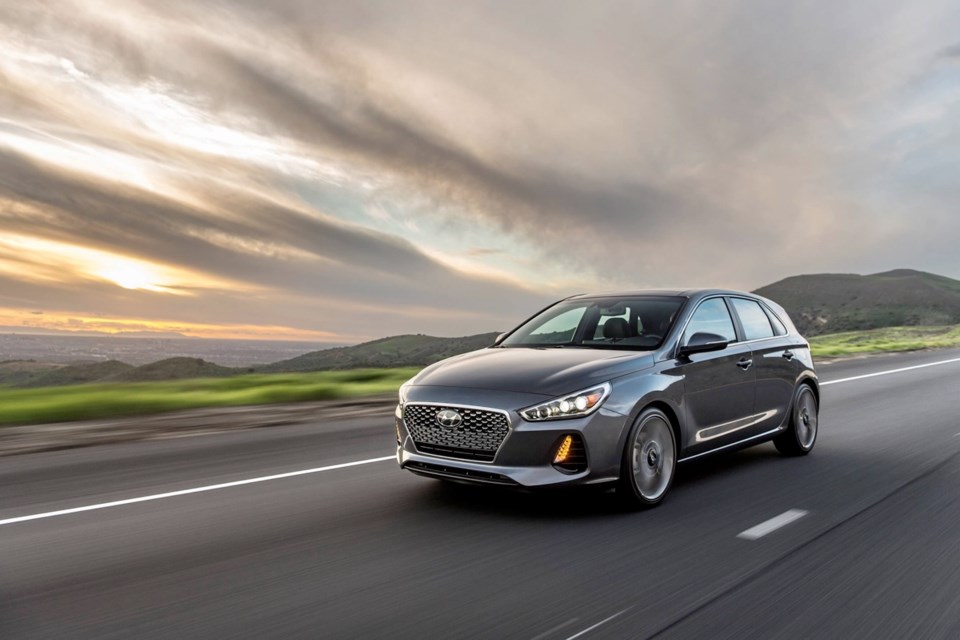The latest member of the 2018 Hyundai Elantra family can be ordered wild or mild, with something for everybody.
The Elantra is typically a compact sedan with a pleasant, fairly conservative appearance that appeals to families, especially American families.
But sa���ʴ�ý is a different kettle of fish, with a small but passionate market segment that just loves its hatchbacks. In a way, we are more like Europe than the rest of North America in our tastes, when it comes to compact cars.
So when Hyundai looked at the feasibility of introducing a five-door hatchback, they did something different. Instead of just slapping on a rear hatch and calling it a day, they went to town, with a body designed with European tastes in mind.
And to make sure people wouldn’t call it just a pretty face, they give buyers a choice of a naturally aspirated or turbocharged engine and an up-level suspension that cut its teeth on the Nürburgring circuit in Germany.
Wow.
The man behind the Elantra GT seeing the light of day is Peter Schreyer, a German auto designer who at one time worked for Audi. Hyundai/Kia hired him away in 2006, and since that time he has steadily transformed the look of the South Korean vehicles from dowdy to dynamite.
The Elantra GT, to me, looks like an Audi A3 Sportback, with an aggressive grille, clean lines, short overhangs and a sporty appearance. You won’t ever read that in any Hyundai literature, but just pull up pictures of the two side-by-side and you will know what I mean. They are within millimetres of each other in length, width — even wheelbase.
But when it comes to the powerplant, the two are worlds apart. Audi has decided that the Sportback will only be offered as a gasoline/electric hybrid in sa���ʴ�ý.
A cheer went up among the engineers at Hyundai, as they went about chasing after another German iconic five-door hatchback — the Volkswagen Golf.
The GT is available with two four-cylinder engines, a 2.0-litre direct injection unit delivering 162 horsepower and 150 foot-pounds of torque, or a turbocharged and intercooled 1.6-litre producing 201 hp and 195 lb.-ft. of torque.
My tester was the Elantra GT GLS Auto, with the standard powerplant. The GT line starts at $20,449, and my tester carried a list price of $24,099. The top-of-the-line model will set you back at least $30,499.
On my tester, the 2.0-litre powerplant was paired with a six-speed automatic — the most common combination requested. Those who prefer to row their own gears can save some money and opt for a six-speed manual transmission.
On the road, the 2.0-litre only felt underpowered when passing. The automatic transmission also had a manual mode to hold the revs just a little longer. The driver can also change throttle response and steering effort by choosing between three driving modes — Eco, Normal or Sport — via a button on the console beside the shifter.
Handling is decent, but if you are planning to take to the back roads with gusto (Hyundai did advertise that it was tuned on that famous German racetrack) keep in mind that the regular GT only has a simple torsion-beam rear end. The superior handling prowess only comes when the GT is equipped with a multi-link rear suspension — found only on the more expensive Sport trim level.
Those without the need for speed will certainly warm to the GT’s creature comforts instead. The GLS is the middle-of-the-pack trim, but you wouldn’t know it stepping inside the cabin.
Just in time for winter, you are welcomed by heated seats and steering wheel — the latter wrapped in leather. There is a proximity key with push-button ignition, a full-size panoramic sunroof and dual-zone automatic temperature control. You only find the superior multi-link rear suspension in the pricier Sport model.
The focal point of the dash is a centre-mounted 8.0-inch touchscreen infotainment centre with Android Auto and Apple CarPlay. There is a back-up camera with one of the clearest images I have encountered in this price range (and more).
Blind-spot detection and rear cross-traffic alert is standard, but if you want autonomous emergency braking or lane-departure warming with lane-keep assist, you will have to pay more.
If you are considering a vehicle to get you and friends and family to the beach or slopes, you will find lots of room to carry your stuff, with more than 700 litres of cargo room with the back seats up and 1,560 with them folded down (that’s more than the Golf and considerably more than the Sportback, despite the same overall size on the outside).
Wild or mild, the GT is a welcome addition to the Canadian market. The regular GT is a practical hatch and is sure to sell. The Sport model, with its more-powerful engine and upgraded suspension is another story, due in part to its more than $4,000 price premium. It will be interesting to find out how many people will shell out more than $30,000 for an Elantra. Stay tuned.
THE SPEC SHEET
Type: Compact five-door hatchback, front engine, front-wheel drive
Engine: Naturally aspirated 2.0-litre four-cylinder, 162 hp at 6,200 r.p.m., 150 lb.-ft. of torque at 4,700 r.p.m.
Transmission: Six-speed automatic
Dimensions (mm): Length, 4,340; width, 1,795; height, 1,465; wheelbase, 2,650
Curb weight (kg): 1,379
Price (base/as tested): $24,099/ $25,904 (includes $1,705 freight and PDI and $100 AC tax)
Options: Nil
Tires: 215/45 R17 on alloy wheels
Fuel type: Regular
Fuel economy (L/100km): 9.8 city 7.3 highway
Warranty: Five years/100,000 km new car



